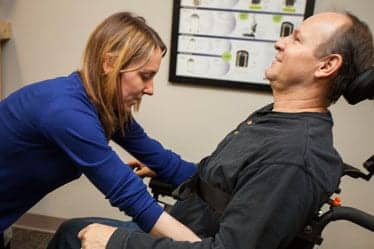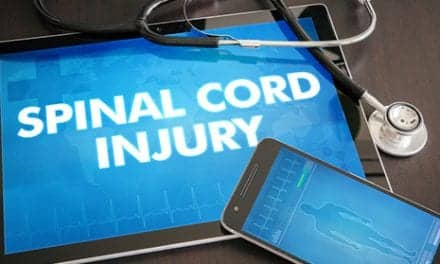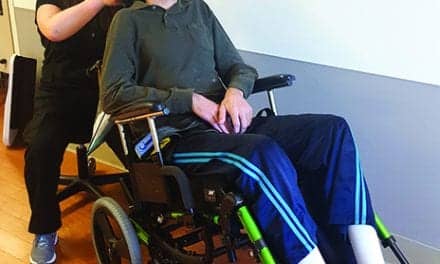Comprehensive evaluations blaze the trail for successful wheelchair seating and mobility outcomes.
by Angela Dillbeck, OTD, OTR, ATP

Comprehensive Evaluation
A comprehensive seating and mobility evaluation is required to assure optimal wheelchair seating and to prevent abandonment of equipment or additional expenses related to addressing inappropriately prescribed equipment. After a clinician receives an appropriate referral, an evaluation should be initiated. Components include:
• Client interview: Completed to determine existing functional patterns and tasks (including observation in current seating system if applicable); functional goals for the new seating system/mobility device; lifestyle; transportation; home and community environments; cognitive, perceptual, and visual impairments that may affect operation of wheelchair or seating components; and psychosocial aspects of utilizing the mobility device/seating components.
• Mat evaluation: Assessment in supine and sitting to identify any range of motion limitations that may affect seated posture, pre-existing deformities, spasticity, muscle strength/imbalances, functional movement, and skin integrity issues (both past and current).
• Collaboration with all key players: Therapists, teachers, doctors, and caregivers.
Consideration of Seating Options and Trial of Equipment
After necessary information is gathered from the interview and mat evaluation, the therapist and vendor must evaluate what options will work best given the client’s identified needs, with ongoing input from both the client and the caregivers. When considering seating, the following wheelchair components should be considered:
• Seating system components: Tilt, recline, seat elevator, elevating leg rests, standing
• Primary support surfaces: back rest and cushion
• Secondary support surfaces: pelvic support, lateral trunk support, anterior chest support, lateral thigh support, medial thigh support, lower extremity support, upper extremity support, head support including appropriate head pad and lateral facial pads/support when needed
• Configuration of primary support surfaces and secondary components
• Switch access and drive system
• Miscellaneous wheelchair accessories: mounts for communication devices, phones, tablets, lap trays, luggage carrier, umbrella holder, cup holders, bags, camera mounts, hunting/fishing mounts
When evaluating seating, it may be beneficial to utilize a pressure mapping system to assure the patient is making adequate contact at the primary support surfaces and there are no areas of high pressure or concern. Pressure mapping can be used to identify areas associated with current or potential skin breakdown, and aid in selection of the most appropriate seating system. While a pressure mapping system can be a helpful tool, it is best used as an adjunct to good clinical reasoning.
Components: Off the Shelf, Modifications, and Custom
When selecting seating system components, one must determine whether off-the-shelf products will meet the needs of the client, or if it is necessary to modify or pursue custom options. When standard products do not meet the need of the user, the clinician and supplier must then determine if an existing off-the-shelf product can be modified, or if a custom product is required. When considering modification of existing products, the options are limitless and dependent on the creativity of the clinician, provider of equipment, and patient. Some examples of modification of standard products include:
• Cushion modification: A patient presents with a flexible pelvic obliquity that he is able to self-correct. A buildup to the cushion on the side of the obliquity can aid the patient in maintaining a more neutral pelvis and can prevent worsening of the tendency. Maintaining a more neutral pelvis will prevent worsening of the obliquity and potential scoliosis.
• Back rest modification: A patient requires use of a back support with lateral trunk support for stability; the patient also presents with a flexible scoliosis, convex on the right. Removable/height adjustable lateral trunk supports are not desired, as the patient has multiple caregivers and the therapist is concerned that the additional parts and pieces of separate, removable laterals will become misplaced. The therapist decides to utilize a back support with built-in contour, and adds a foam buildup to the lateral contour of the back rest (low on right to address convexity, higher on left to reduce tendency of left lateral flexion) to address the scoliosis, thus preventing use of additional parts/pieces, but properly addressing his postural needs.
• Upper extremity support: A patient presents with limited range of motion in his right elbow, resulting in an inability to obtain necessary contact with the arm pad if it is mounted in a standard location. In addition, because the arm pad must be mounted at an anterior downward angle, the patient also requires a support at the front of the armrest for a place to rest his hand. The therapist decides to utilize an angle-adjustable mounting bracket with a flat pad, and places a contoured elbow block at the front of the pad for distal support to aid in keeping the upper extremity from sliding forward on the pad.
If the client’s needs cannot be met by off-the-shelf products or modification of off-the-shelf products, custom options should be pursued. There are several different options for custom primary and secondary support surfaces such as custom molded, planar, and foam-in-place. In addition to primary and secondary support surfaces, the client may require custom accessories to maximize independence in operation of the wheelchair (eg, custom joystick knob) or to address vocational/recreational goals, and participation in life roles. Examples include:
• Custom joystick knob: A patient with a spinal cord injury presents consistent with a weak C5 complete level of injury. She has difficulty with forearm pronation, and tends to drive the wheelchair with her forearm supinated. The use of a custom V-shaped joystick allows her to remain in a neutral forearm position for driving and helps her to maximize control of the power wheelchair.
• Custom tray: A client with a C4 complete spinal cord injury requires the use of a lap tray for tablet access and reading. He also requires that his mouth-stick have a docking station, and that the lap tray stay stable when completing a pressure relief using a powered tilt seating system. The therapist works in conjunction with a rehabilitation engineer to fabricate a tray that mounts to the seat frame, but remains easily removable for transfers. The tray also articulates depending on the task it is required for, and has built-in page holders and mouth-stick docking station.
• Custom belt for parenting role
Funding Challenges
After appropriate equipment options are evaluated, the therapist and equipment vendor work on obtaining funding for the procurement of the recommended equipment. Thorough justification for the mobility device, necessary seating functions, components, and accessories must be provided based on the client’s medical and functional needs. While the majority of third-party payors are focused primarily on medical necessity, it is important to include the client’s (and caregivers’) functional needs and goals as well. For example, while some third-party payors will not cover swing-away joystick mounting brackets or transport ready options, these components may be required to maximize independence and safety of the client and thus should be included in the recommendation and justification.
When insurance coverage does not provide funding for all recommended components, individuals involved may need to pursue other options such as private pay, vocational rehabilitation, fundraising through local nonprofit organizations, religious affiliations, or other community organizations. When providing recommendations to the client, it is important to discuss potential funding issues and alternate options from the beginning to assure the client and their support system are well informed and invested in the process.
Recommendation of all equipment thought to be necessary to the client, despite potential funding issues, is vital. In taking a comprehensive approach that addresses both the medical and functional needs of the client and caregivers, outcomes will be optimized. While modifying and customizing equipment can initially be more costly, proper equipment can prevent worsening of deformities, help maintain skin integrity, and optimize functional independence—in the long run saving money.
Changes Throughout the Lifespan
Individuals who have complex seating and mobility needs will be best served by re-evaluation of their positioning and mobility needs throughout the lifespan. With aging and potential progression of the disease process, seating needs will vary. While a specific seating intervention works well now, the client’s functional needs and physical presentation will inevitably change. For example:
• Individual aging with paraplegia: John is a 57-year-old with a T8 complete spinal cord injury. He has used an ultra-lightweight manual wheelchair for 23 years. He returns for a re-evaluation of his seating and mobility needs, reporting increasing shoulder pain over the past year, particularly when transferring and when propelling his manual wheelchair. In addition to evaluating his daily routine (number of transfers, transportation, other activities that may strain the shoulders), it is determined that transition to a power wheelchair for community mobility will help maintain optimal independence and reduce strain on the shoulders.
Summary
To assure a successful wheelchair seating and mobility outcome, a comprehensive evaluation must be completed. A vital part of this process is identification of appropriate seating components to meet the client’s functional and medical needs, including consideration of modification or custom option. While the number of options can be overwhelming, it is important to thoroughly evaluate appropriate equipment and obtain feedback from the client and caregivers throughout the process. As clinicians, we understand postural needs, but often patients and/or caregivers understand a patient’s functional needs better. Working with the client and integrating their feedback into the process assures an optimal outcome and minimizes abandonment and costly changes to equipment.
Clinical Resources
While a comprehensive explanation of the evaluation and justification process is beyond the scope of the article, there are many free resources available online for clinicians wishing to learn more about wheelchair seating and mobility.
• PVA Clinical Practice Guidelines (Preservation of Upper Limb Function Following Spinal Cord Injury): www.pva.org • RESNA Position Papers and Guides: www.resna.org/resources/position_papers.dot
• Seating and Mobility Evaluation Resource: http://www.aci.health.nsw.gov.au/networks/spinal-seating
• AbleData: www.abledata.com RM
Angela Dillbeck, OTD, OTR, ATP, is an occupational therapist and Assistive Technology Professional at Craig Hospital in Englewood, Colo. She works full time in the DME Clinic at Craig Hospital, evaluating the seating and mobility needs of individuals with traumatic brain and spinal cord injuries. For more information, contact [email protected].





